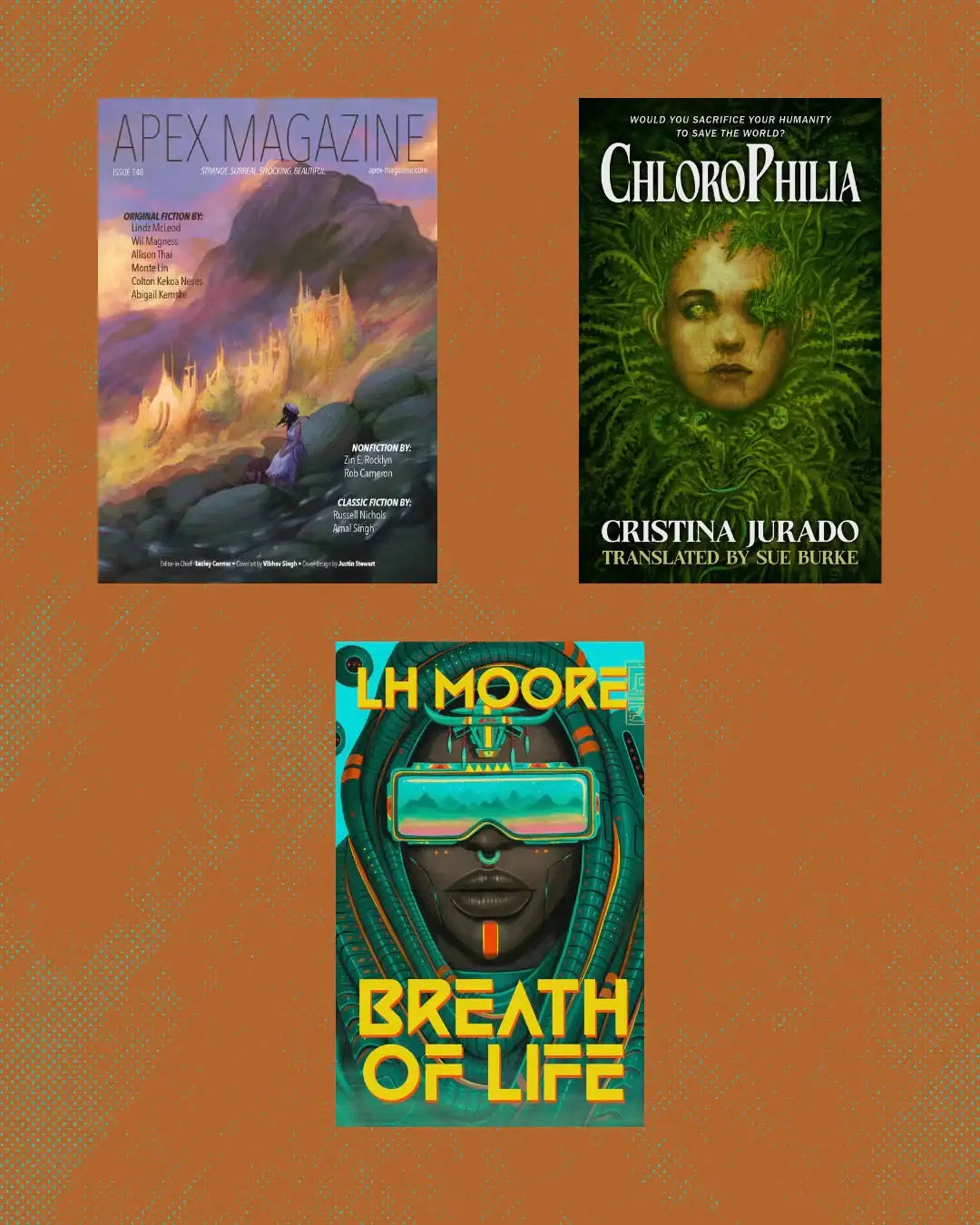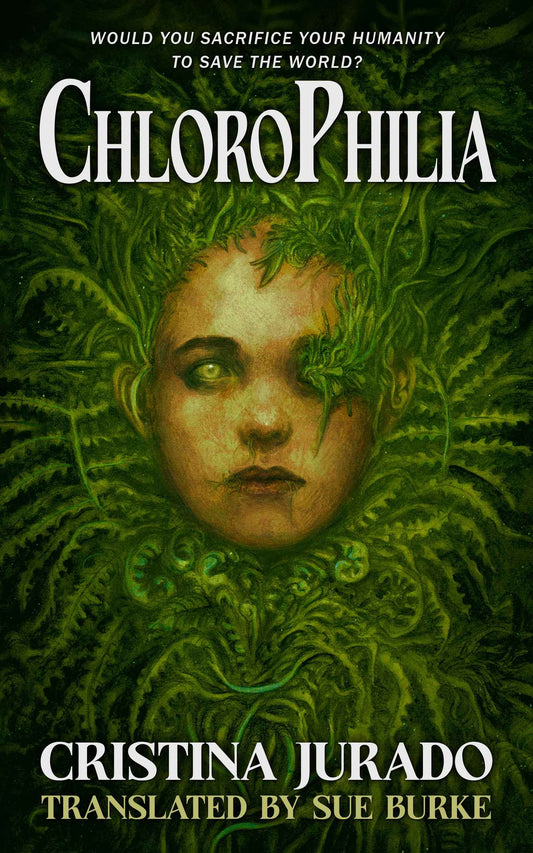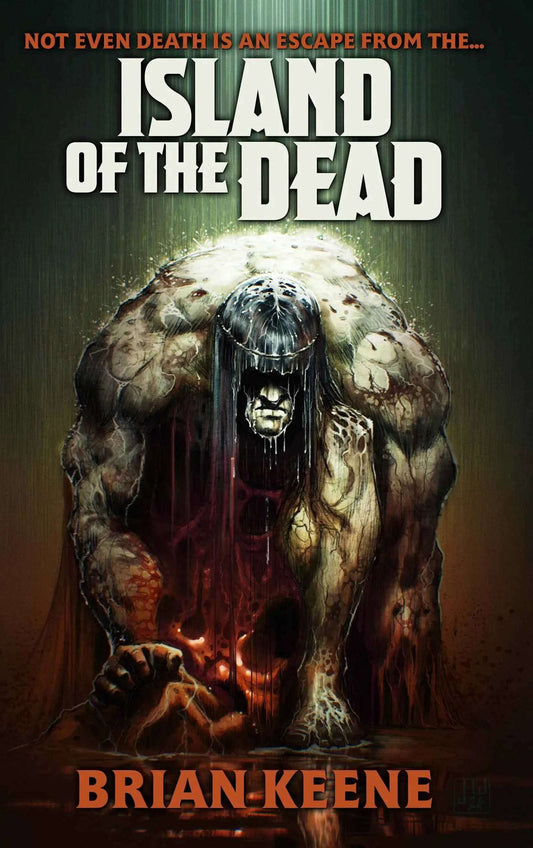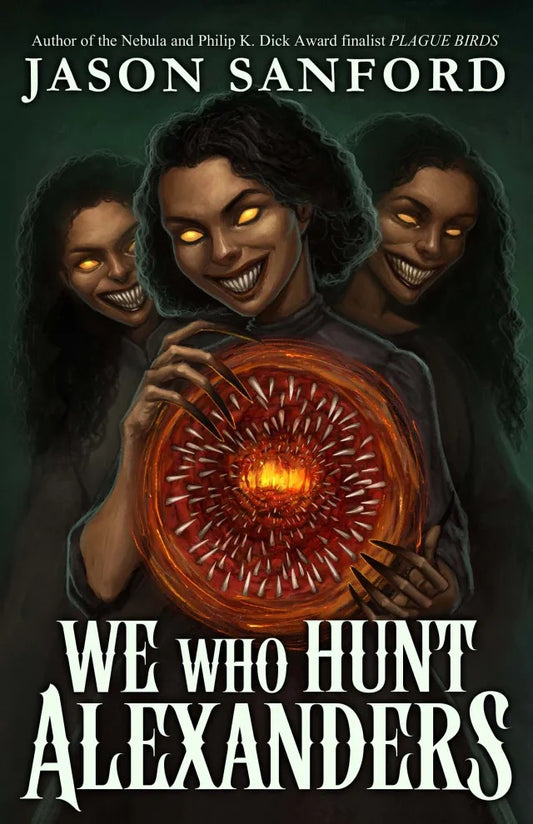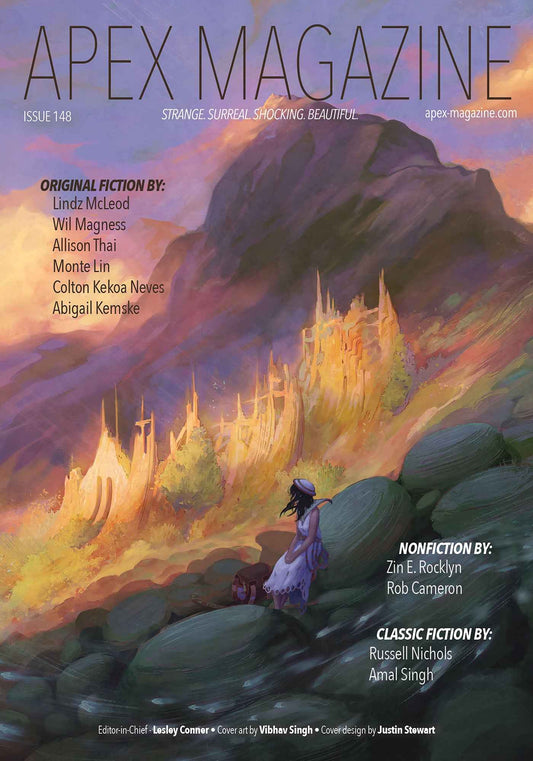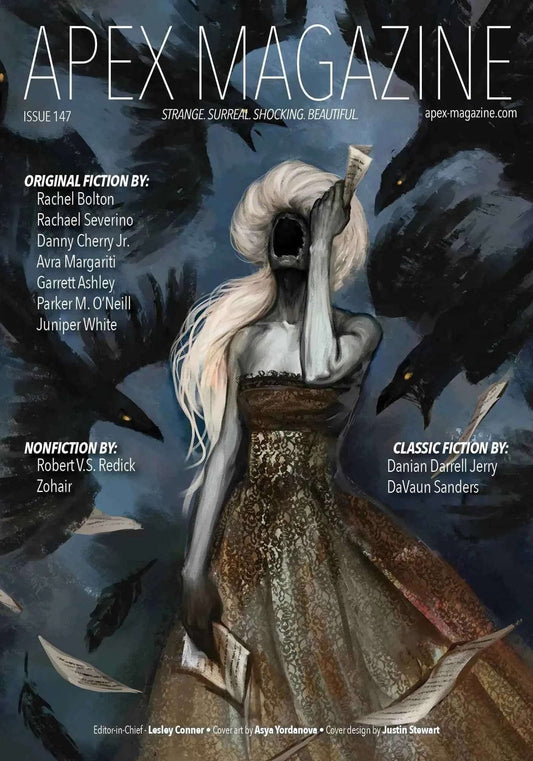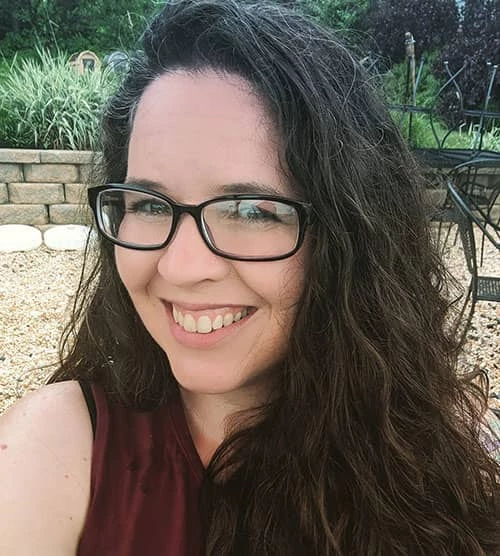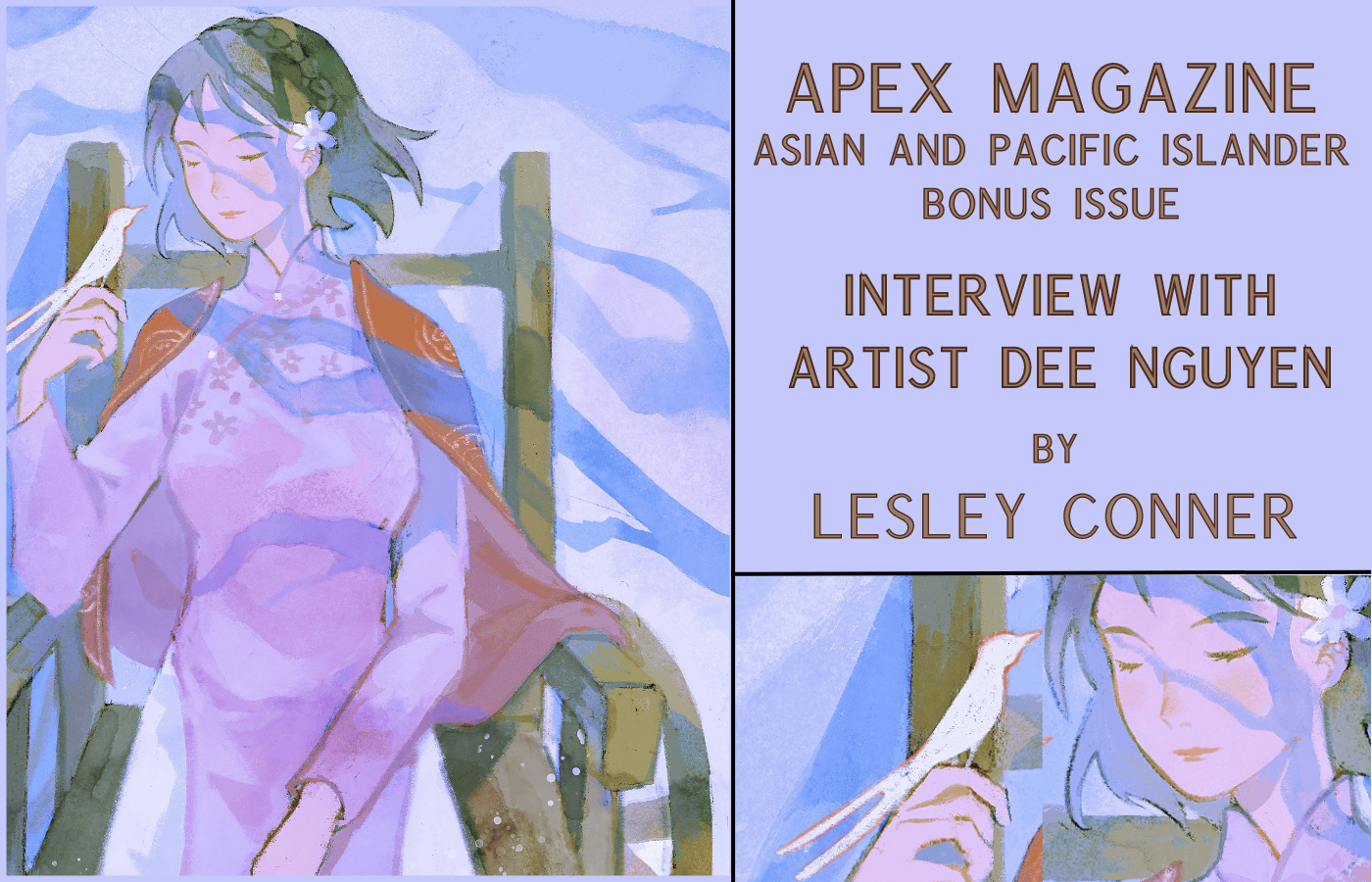
Issue 137’s cover artist is the wonderful Dee Nguyen. Nguyen’s portfolio is brimming with art that invoke a sense of movement and rich emotion. The use of white and shadows adds a textured feel that is absolutely stunning. In addition to being a talented artist, she is also currently a pharmacy student, juggling work, her studies, and art.
Dee Nguyen is a Vietnamese-American pharmacy student by day and illustrator every other hour. She loves working with colors and mood to tell stories, often highlighting her own Vietnamese background.
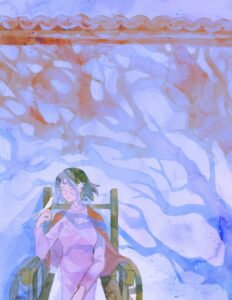 Issue 137 cover art
Issue 137 cover art
LESLEY CONNER: First, thank you so much for taking the time for this interview and for contributing this absolutely stellar piece of artwork for our cover. You mention in your bio that you use your artwork to highlight your Vietnamese background. Can you talk a bit about why this is so important to you and the impact you think it has on your work?
DEE NGUYEN: Thank you for having me, I’m very honored! I was born in Vietnam and immigrated to the United States when I was relatively young, so I’m in this awkward area retaining the language enough to carry conversations and knowing enough about the culture to celebrate important holidays, but there’s so much I have forgotten or don’t know. Incorporating Vietnamese influences in my work is a way for me to learn and re-learn—I have a lot of fun doing research on traditional clothing, customs, history, and folklore and finding ways to weave them into my art. I don’t dare claim to do anything to promote or educate on Vietnamese culture, and in fact I would be doing a bad job if that was my goal. It’s the process of reconnecting and discovering and playing that is important to me as a member of the diaspora.
As for the impact that it has on my art, I really like the cohesiveness that it’s given my portfolio. It’s also pushed me creatively to branch out into drawing different environments and compositions, and to develop my story-telling skills to make characters look like they believably live in those moments. It’s all still very much a learning process, and I’m very excited to keep working on these skills!
LC: The movement conveyed in your artwork is absolutely stunning. Whether it’s the flight of birds, ribbons or plants bending in the wind, or the way clothing is draped, I feel like I can see the movements implied. Is this a technique you really strived to work on and develop or is it something you feel came more naturally through the nature of your work?
DN: Thank you, I definitely strive to work on it! My earliest art influence was probably CLAMP, from whom I read Cardcaptor Sakura and Tsubasa Reservoir Chronicles, and I guess the flower petals and wisps of hair blowing in the wind never left me. Ever since, I don’t think I’ve stopped loving that sense of movement in the art that I find inspiring. For a time I drew a lot of inspiration from Baroque Christian art (kind of hard to see that, I know!) not only for their cool motifs but also how wonderfully the figures are posed—simultaneously delicate yet dynamic. Many of the East Asian artists I’ve been admiring lately incorporate movement through background elements like flames, clouds, mountains, in ways that I find just breathtaking. With my own art, I want to instill that sense of levity and suspension, like the moment when a breath is drawn in and held, and so I try hard to do that in my compositions. It’s gotten more natural now that I’ve been working at it for a while, but it’s still something I’m learning and experimenting with daily!
LC: Can you talk a little bit about the importance of color and how that can shape the mood of a piece?
DN: Most people already about the common associations we have with some colors; red is aggressive, blue calming, and so on. Something I’ve come to learn as an artist, as I’m sure many other artists know, is that it’s not just the use of a single color that makes the mood, it’s the combination of colors in a palette, and even more important is the values and saturation of those colors. The same bright red can work beautifully in a sun-dappled summer scene with other saturated colors of similar values, or as the dominant background color in piece where the foreground is desaturated and of darker values to bring about a sense of alarm or eeriness, or tastefully used in a piece composed predominantly of blues to highlight (for example) a line of blood. Blues can be both melancholic and calming, greens both sinister and vivacious, yellows both nostalgic and opulent. The same scene can feel come completely different with a different set of colors. There are infinite ways that colors and be combined to set a spectrum of moods, and it’s one of the greatest joys of being artist to figure some of that out for myself.
LC: You’re currently a pharmacy student, which I’m sure takes up a lot of your time and mental energy. How do you find the mental bandwidth to then work on your artwork after a long day of studies?
DN: If I’m honest, sometimes I prioritize my art ahead of my studies! I’m no superhuman—there’s no way I can do what I do and give 100% to both parts of my life. It’s a lot of deciding what is truly important to me and making many, many compromises and sacrifices. There are clubs, activities, and research in the pharmacy field that I will probably never pursue, as much as I wish I could, because I don’t have the energy or time. There are creative projects and ambitions that will take me quite a long time to execute because I still need to concentrate on my studies. I most definitely don’t sleep as much as I should, exercise as much as I used to, or see my friends as often as I’d like. This is not the greatest way to live, probably! And I would not advise anyone to do as I do! But it’s a decision I’ve made for myself because I see art as something very important to me and something I’m unwilling to give up no matter what.
LC: To follow up with that, can you discuss your daily routine? How do you find the time for your studies, art, and day to day life?
DN: Sure! Finding time, for me, is a matter of multi-tasking and doing a little bit here and there. I wake up and walk to class about 2 miles away, which I love to do because it gives me a chance to read or listen to audiobooks and ideate on art projects—the mental part of the creative process! In lectures I sometimes like to work a little on my comic script. I stay on campus until mid-afternoon, then go home. If I have work, then I head to the hospital pharmacy for my shift until about 9:30 pm. In my downtime at work, I look through my class notes. If I don’t have work, when I get home it’s lunch and chores and then I work on and off on my studies. Most days I work with my dinner on the side, because I know if I joined my roommates for theirs I wouldn’t be able to go back to my room for a couple hours, haha, but when I have time I do! I do my studies until I get sick of it, usually around 11 pm, at which point I give up and just draw. Once I start drawing, I zone out for a couple of hours, and most days it’s around 3 am when I realize it’s time to sleep (OOPS). My class load fluctuates, so some days I have the time to go see friends or draw more, or some I would have to go without making art, it really depends. It’s a delicate balancing act, but one that I suspect many creatives aren’t unfamiliar with.
LC: You wrote and drew a comic called “Mulberry Season.” What was the process of completing a comic versus standalone pieces of art, and is writing comics something you hope to be able to do more of in the future?
DN: Oh man, I find comics just so, so cool, especially in the ways that they play with space and time as well as make use of the physicality of the reader’s interactions with the medium … I am incredibly in awe of the greats of comic art. I myself am very much a beginner to long-form comics and it’s quite difficult because the process and considerations are vastly different than standalone pieces! For example, with “Mulberry Season” (which actually is nowhere near completion, haha), there’s a lot of text and dialogue involved. I’ve never considered myself a writer! I’m used to capturing a moment in time and visual storytelling using symbols, compositions, atmosphere, etc, but not establishing characters and crafting an arc for them, constructing a story with a coherent start and end, or writing dialogue that doesn’t feel stiff. There is so much planning involved because you must make a whole world for your characters to move through, figure out the pacing of the story, and so on …
For “Mulberry Season,” which very tied to the setting in the Vietnamese northern highlands, I first spent a chunk of time researching things like what the climate of the region is at certain times of the year, what the life cycles of certain plants and creatures are like, who lives there, etc. I wrote an outline for the story, trying to align as much of my research with it as possible. Then, I divided the outline into chapters that would be posted as I completed them, figuring out the pacing at this point. Finally, I drafted up a script for each chapter before drawing the images. This is nowhere near the level of pre-work that I do for standalone pieces. To be honest, it’s all very touch-and go. I have no idea what I’m doing, where things are going, and if I’ll ever manage to finish the comic, but I’ve enjoyed the process so far and have learned tons just through trying. I do have a great respect and passion for comics, and I definitely would love to work on more in the future!
LC: Thank you so much, Dee!
To check out more of Dee’s artwork, as well as her comic “Mulberry Season,” visit her website: https://idledeeart.wixsite.com/idledee.
